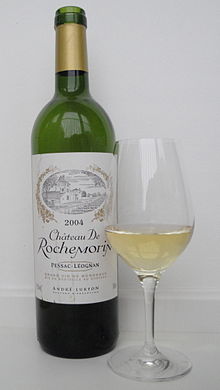Pessac-Léognan
The Pessac-Léognan area is a wine-growing region in the Graves wine-growing region , part of Bordeaux .
Since September 9, 1987 it has had the status of an independent Appellation d'Origine Contrôlée (AOC for short). An average of 68,500 hectoliters of wine are harvested from around 1288 hectares of vineyards. 1000 hectares are dedicated to the red grape varieties; the remaining 288 the white varieties.
Soil and climate
The name Graves derives from the stony ground (gravier: pebble), which is called Las Grabas de Bourdeus in the local language . The nutrient-poor soil is littered with stones. These stones store the sun's energy during the day and give off the heat at night. This creates a very favorable microclimate that benefits the vines. The Pessac-Léognan area extends from the city of Bordeaux in the north to the municipality of Martillac in the south on an approx. Ten kilometer long and max. six kilometers wide strip. The area is protected by pine forests to the west and south. To the east, the Garonne River serves as a heat store.
The climate is mild and humid. The annual average temperature is 12.9 ° C and the average sunshine duration is 1991 hours / year. The precipitation is spread over the whole year. The amount of 833 l / m² per year falls on 170 days a year.
history
2000 years ago the Romans planted the first Bordeaux vineyards here, and the Roman author Columella enthusiastically reports on the excellent wines. In 1154, Eleanor of Aquitaine , who came from Aquitaine, became Queen of England. During her reign, trade relations between Bordeaux and England were greatly expanded. Around the year 1300, the Archbishop of Bordeaux, Bertrand de Got, and later Pope Clemens V, founded a winery that still exists today under the name of Château Pape-Clément . The wines from Graves established the fame of Bordeaux at that time. From 1531 to 1551, Jean de Pontac planted a vineyard in the Haut-Brion district, which was the first great quality Bordeaux winery under the name Château Haut-Brion . In the 18th century, Charles de Secondat, Baron de Montesquieu (1689–1755) contributed much to the growing popularity of both the courts of Paris and England. He was born at Château La Brède and throughout his life had an open ear for the needs of the winegrowers from Graves.
From 1908 to 1981 alone, 238 wineries were given up in the immediate vicinity of the city of Bordeaux. Four of the most famous wineries in the area are now located within the densely built agglomeration of Bordeaux. Château Haut-Brion , Château Les Carmes-Haut-Brion and Château Pape-Clément are in the suburb of Pessac , and in Talence is Château La Mission Haut-Brion .
In 1953, 16 wineries were classified that are allowed to carry the title Cru Classés de Graves. All classified châteaux are located in the Pessac-Léognan sub-region.
Classification of the Graves region
When Château Haut-Brion was given the top tier of Premier Grand Cru in the Bordeaux wine classification of 1855 , it was the only estate from the Graves region to be honored with the classification. The long-cherished wish for a similar list for the Graves was met by an amendment to the law from 1949. Therefore, a first classification was not published until August 7, 1953, which was finally defined by a revision of February 16, 1959. It is noticeable that all classified plants in the Graves region come from the Pessac-Léognan appellation.
Classified for red and white wine:
- Château Bouscaut from the municipality of Cadaujac
- Château Carbonnieux from Léognan
- Domaine de Chevalier from Léognan
- Château Latour-Martillac from Martillac
- Château Malartic-Lagravière from Léognan
- Château Olivier from Léognan
Classified only for red wine:
- Château Haut-Bailly from Léognan
- Château Haut-Brion from Pessac
- Château de Fieuzal from Léognan
- Château La Mission Haut-Brion from Talence
- Château Pape-Clément from Pessac
- Château Smith Haut Lafitte from Martillac
- Château La Tour Haut-Brion from Talence
Classified only for white wine:
- Château Couhins from Villenave-d'Ornon
- Château Couhins-Lurton from Villenave-d'Ornon
- Château Laville-Haut-Brion from Pessac
Approved grape varieties
For the red wines , the grape varieties Merlot (average share 46%), Cabernet Sauvignon (average share 49%), Cabernet Franc , Malbec and Petit Verdot admitted. The appellate regulation provides for a harvest restriction of 45 hectoliters / hectare.
In the case of white wines come Semillon (medium share 69%), Sauvignon Blanc (medium share 29%) and Muscadelle used. Here, the appellate regulation provides for a harvest restriction of 48 hectoliters / hectare.
Approved municipalities
Cadaujac , Canéjan , Gradignan , Léognan , Martillac , Mérignac , Pessac , Saint-Médard-d'Eyrans , Talence and Villenave-d'Ornon
